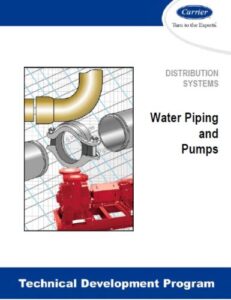Carrier TDP 502 DISTRIBUTION SYSTEMS Water Piping and Pumps
Carrier TDP 502 DISTRIBUTION SYSTEMS Water Piping and Pumps
Technical Development Programs Carrier TDP 502 DISTRIBUTION SYSTEMS Water Piping and Pumps are modules of technical training on HVAC theory, system design, equipment selection and application topics. They are targeted at engineers and designers who wish to develop their knowledge in this field to effectively design, specify, sell or apply HVAC equipment in commercial applications.
Although TDP topics have been developed as stand-alone modules, there are logical groupings of topics. The modules within each group begin at an introductory level and progress to advanced levels. The breadth of this offering allows for customization into a complete HVAC curriculum – from a complete HVAC design course at an introductory-level or to an advanced level design course. Advanced-level modules assume prerequisite knowledge and do not review basic concepts.
You can also read Carrier TDP 301 COMMERCIAL LOAD Estimating Level 2 Fundamental
Carrier TDP 502 DISTRIBUTION SYSTEMS Water Piping and Pumps Content
- Introduction
![Carrier TDP 502 DISTRIBUTION SYSTEMS, Water Piping and Pumps]()
- Types of Piping Systems
- Water Distribution Systems
- Direct and Reverse Return Systems
- Water Piping Components and Accessories
- Hydronic System Components
- Typical Piping Details at Equipment
- System Piping Arrangements
- Pump Basics and Types of Pumps
- Pipe Sizing and Pump Selection Example
- Summary
- Work Session
- Appendix
- References.
- Charts and Tables
Water piping and pumping is a fundamentals topic of HVAC design. The correct layout, selection and sizing of the piping system and associated hydronic components required to properly deliver chilled and hot water as required to maintain comfort conditions. Piping connections at various equipment are covered, along with piping arrangements for chilled water systems. Pump basics, pipe sizing, and a pump selection example complete the TDP.
There are important components and accessories that required to complete a water piping system. These include valves, tanks, and air eliminators. We will examine these system components and define their role in the total hydronic system.


Comments are closed.